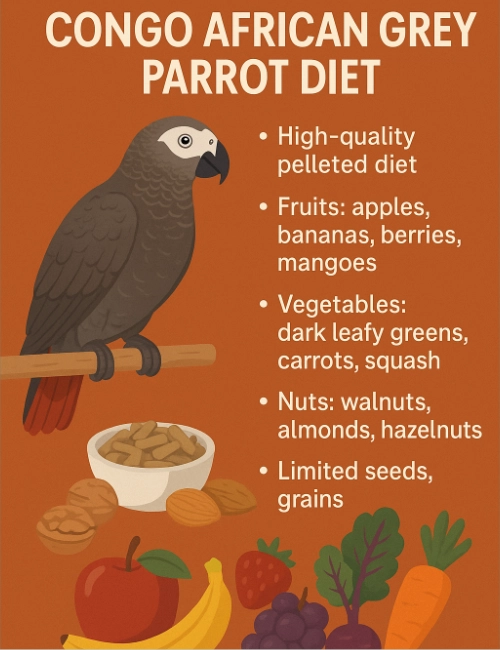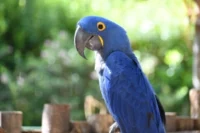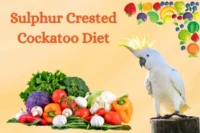Congo African Grey Parrot Diet
Published: 15 May 2025
A healthy Congo African Grey Parrot diet is key to keeping your bird active, intelligent, and happy. These parrots are incredibly smart and sensitive, so the food they eat directly affects their brain, feathers, mood, and lifespan. A well-balanced diet ensures they stay energetic and live up to 40 years or more.
In this guide, you’ll learn the essentials of feeding your Congo Grey the right way to support a long and healthy life.
Why Diet Matters for your Congo Grey
A good diet keeps your parrot’s body, mind, and mood in perfect balance.
- A poor diet can lead to feather plucking, illness, or mood swings
- Nutrition supports brain function, feather quality, and trust-building
- Healthy eating equals a happy, well-behaved parrot

Daily Nutrients Needs of Congo African Greys
Congo Greys need both macro- and micronutrients to stay healthy and active.
Macronutrients:
- Protein – builds muscles and feathers
- Fats – provides energy and shiny plumage
- Carbs – grains and veggies offer natural fuel
Vitamins & Minerals:
- Calcium – supports bones and beak
- Vitamin A – boosts immunity and vision
- Vitamin D3 – helps calcium absorption
- Iron & Zinc – improve blood and skin health
What to Feed Daily your Congo Grey
Feed a mix of pellets, fresh foods, and occasional treats for balanced nutrition.
- Pellets (60–70%) – organic, no dyes; try Harrison’s, TOP’s, ZuPreem
- Fruits – apple, papaya, berries, mango, banana
- Vegetables – spinach, broccoli, kale, carrots, bell peppers
- Seeds (in moderation) – flax, hemp, chia
- Nuts (unsalted, raw) – almonds, walnuts, pistachios
- Grains – cooked oats, brown rice, quinoa
Foods You Must Avoid
Avoid these foods completely as they can be harmful or deadly to parrots.
- Avocado – toxic
- Chocolate & caffeine – harm the nervous system
- Onion & garlic – damage red blood cells
- Alcohol & salt – cause dehydration and organ failure
- Apple seeds & fruit pits – contain cyanide
Feeding Schedule For Congo Grey
Feeding on a routine helps with digestion, energy levels, and behavior.
- Morning – fresh fruits and vegetables
- Afternoon – pellets and grains
- Evening – a few nuts or a light meal
- Clean bowls daily and remove uneaten food within 2 hours
Homemade Food Ideas for Congo Grey
Homemade meals keep things fun and add variety to your parrot’s routine.
- Parrot Chop – finely chopped veggies, fruits, grains
- Veggie Mash – steamed carrots, peas, quinoa
- Fruit Skewers – diced fruit on safe wooden sticks
- Always use stainless-steel bowls, never non-stick cookware
Common Feeding Mistakes to Avoid
Avoid these typical errors to keep your parrot healthy and happy.
- Feeding too many seeds or fruits
- Skipping vitamin D3 for indoor birds
- Giving human snacks like bread or chips
- Not rotating food items regularly
Congo vs. Timneh Diet
Congo Greys need slightly more food due to their size, but the basics are the same.
- Congo Greys are larger, needing more food and water
- Timnehs mature faster and may be less picky
- Both thrive on the same balanced diet principles
Seasonal Tips
Use fresh seasonal ingredients to add variety and enrichment to meals.
- Summer – melon, cucumber, fresh herbs
- Winter – warm grains, steamed root veggies
- Use foraging toys or food puzzles for mental stimulation
Signs of a Healthy Diet
Watch for these signs to know your bird’s diet is on the right track.
- Bright eyes and clean nostrils
- Smooth feathers and active behavior
- Regular droppings and healthy weight
- Any sudden changes? See an avian vet
Useful Supplements
Supplements help fill nutritional gaps, especially for indoor birds.
- Calcium with D3 – vital for bone health
- Probiotics – aid digestion
- Omega-3 oils – support brain and feathers
- Use supplements only after consulting a vet
Vet Tips for Keeping Your Congo African Gray Healthy
Expert advice helps keep your feeding routine smart and effective.
- Follow the 80/20 rule: 80% pellets, 20% fresh foods
- Weigh your parrot weekly
- Adjust diet if energy, droppings, or mood changes
Feeding by Life Stage
Your parrot’s needs change with age and adjust diet accordingly.
- Chicks – soft food, high protein
- Adults – variety of fresh and pellet-based meals
- Seniors – easy-to-digest foods and joint support
- Always offer fresh, filtered water
Conclusion
So guys in this article we have discussed Congo African Grey Diet in detail. Feeding your Congo African Grey Parrot the right diet isn’t just about nutrition it’s about building a strong bond and giving your bird the best chance at a long, happy life. A balanced Congo African Grey Parrot diet supports not only their physical health but also boosts mood, energy, and trust. By making mindful food choices, you’re creating a daily routine filled with love, care, and connection.
Want to learn more? Check out our other article on parrot care guides and become a pro bird parent today!
✅ 10 FAQs About Congo African Grey Parrot Diet
Let’s answer some of the most important questions about the Congo African Grey Parrot’s diet.
High-quality pellets make the best base. They provide balanced nutrients and are easy to digest. Choose organic, dye-free options like Harrison’s or TOP’s.
Yes, both bananas and apples are safe in moderation. Always remove apple seeds. Offer fruit as a snack, not a main meal.
Feed your bird 2–3 small meals a day. Stick to a consistent schedule. Remove fresh food after 1–2 hours to keep it clean.
Avoid avocado, chocolate, onions, garlic, and alcohol. These can cause severe health issues or even death. Always double-check before introducing a new food.
Yes, especially if they don’t get natural sunlight. Calcium with vitamin D3 is essential. Only supplement under a vet’s guidance.
Only some human foods are safe like plain rice or steamed veggies. Never feed junk food or anything salty or spicy. Keep meals simple and bird-safe.
Bright eyes, shiny feathers, and good energy mean your bird is thriving. Normal droppings and a steady weight are also good signs. Changes may indicate diet issues.
Only in small amounts as treats. Too many nuts can cause obesity. Stick to raw, unsalted options.
Go slowly and add one food at a time. Use small pieces and mix them with known favorites. Praise your bird when it tries something new.
Yes, they can eat cooked grains and steamed veggies. Avoid spices, oils, or butter. Cook only with bird-safe utensils.

- Be Respectful
- Stay Relevant
- Stay Positive
- True Feedback
- Encourage Discussion
- Avoid Spamming
- No Fake News
- Don't Copy-Paste
- No Personal Attacks

- Be Respectful
- Stay Relevant
- Stay Positive
- True Feedback
- Encourage Discussion
- Avoid Spamming
- No Fake News
- Don't Copy-Paste
- No Personal Attacks





